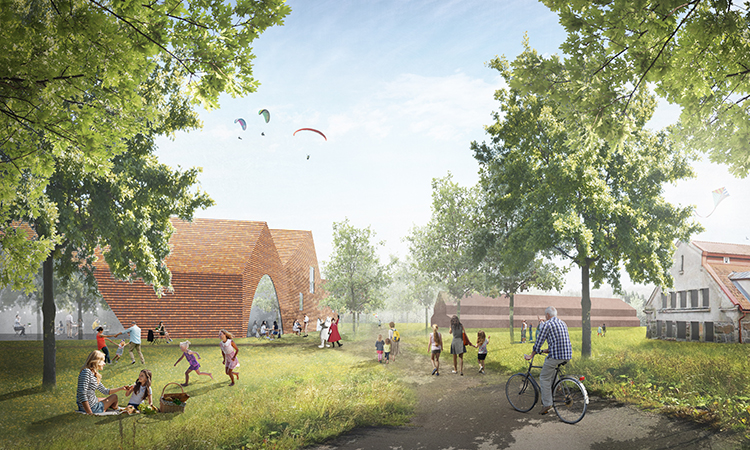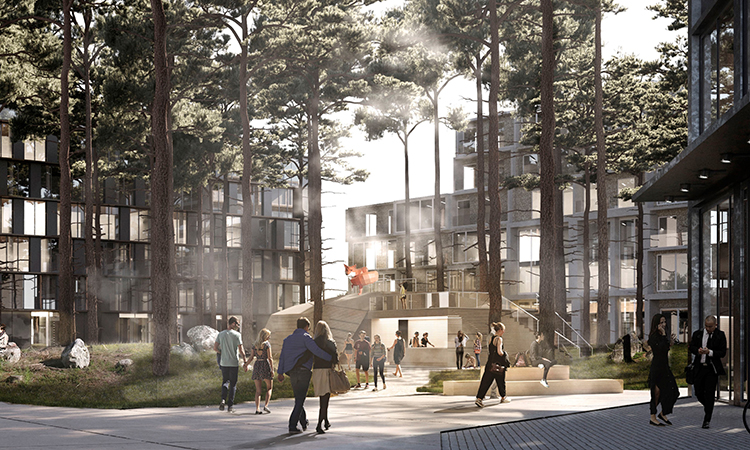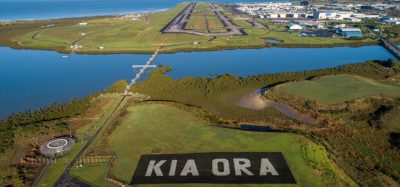Does the idea of the ‘airport city’ still fly?
- Like
- Digg
- Del
- Tumblr
- VKontakte
- Buffer
- Love This
- Odnoklassniki
- Meneame
- Blogger
- Amazon
- Yahoo Mail
- Gmail
- AOL
- Newsvine
- HackerNews
- Evernote
- MySpace
- Mail.ru
- Viadeo
- Line
- Comments
- Yummly
- SMS
- Viber
- Telegram
- Subscribe
- Skype
- Facebook Messenger
- Kakao
- LiveJournal
- Yammer
- Edgar
- Fintel
- Mix
- Instapaper
- Copy Link
Posted: 6 July 2021 | Arja Lukin | No comments yet
Undoubtedly, the effects of the coronavirus crisis have been felt keenly in airport cities across the globe. Arja Lukin, Project Director of Airport City Aviapolis, details the development of Finland’s Aviapolis and its future plans, and considers if the airport city concept is still relevant as the industry battles the pandemic.


Credit: Avanto Architects Ltd
Over the past few years, airport cities have been built rapidly as airport companies have searched for new sources of growth to diversify their revenue. Airport regions have turned into national growth targets that cities, regions and states have supported to promote the economy and employment. Key figures have been in diligent use: a million flight passengers bring around 1,000 jobs for the region’s service industries.
Airport regions have turned into national growth targets that cities, regions and states have supported to promote the economy and employment”
COVID-19 emptied the skies, silenced airport cities and rapidly turned eyes toward non-passenger revenues. As international air traffic and tourism slowed down, airport cities have entered the biggest crisis in their 20-year urban history. It is time to find out whether the idea of the ‘airport city’ still flies.
Airport City Aviapolis, located right next to Helsinki Airport (HEL), is Finland’s utmost growing job and enterprise centre. The area has industry, logistics and knowledge-intensive jobs, as well as excellent local services. Aviapolis’ businesses have benefited from their location at the green-route hub: passenger traffic, freight traffic and logistics utilise the shortest, and lowest emission, route between Europe and Asia. Aviapolis has developed into a unique airport city in terms of its connectivity and internationality.
So, how is Airport City Aviapolis being currently developed? And, importantly, what have we learned from the coronavirus pandemic so far?
Solutions for major challenges will be built together
Air traffic business, Helsinki Airport and Airport City Aviapolis are crucial for the Finnish national economy and, because of Finland’s geographic location, for the country’s connectivity to the rest of the world. The airport and Aviapolis are building the competitiveness and innovativeness of the Helsinki metropolis, as well as Finland as a whole. The area produces around four per cent of Finland’s Gross Domestic Product (GDP).
Because of its internationality, Aviapolis encounters first-hand the world’s mega-trends, as well as unpleasant surprises, such as COVID-19″
Because of its internationality, Aviapolis encounters first-hand the world’s mega-trends, as well as unpleasant surprises, such as COVID-19. Changes in work, housing and mobility are interconnected into a complex whole that challenges the development of the airport, air traffic and the airport environment.
Aviapolis’ solutions for major challenges will be built together with different actors. The main actors of the airport city – the airport operator Finavia, the domestic carrier Finnair, and the City of Vantaa – lean on one another and on the versatile airport ecosystem. Aviapolis is a city-driven airport city development where investments and, finally, changes will be made by a strong community of 2,000 businesses, as well as the area’s more than 100 private landowners. Crisis strengthens cooperation.
Aviapolis no longer only measures growth in money. The network of actors is committed to its Green Deal Manifesto. Climate and nature-based acts create keys to success for businesses and build a more pleasant city for the residents, as well as bolster the brand of the entire airport ecosystem. Above all, although climate challenges are solved locally, their impact is global.
Diversity brings strength
The lengthening COVID-19 situation continues to test businesses’ resilience. Studies show that the impacts of coronavirus are more drastic in Aviapolis than elsewhere in Finland. According to a survey conducted in December 2020, air traffic-related activities – such as tourism, accommodation and traffic – have suffered significantly. On the contrary, convenience stores and special stores, industry and construction have coped well, regardless of the COVID-19 situation. ‘Only’ 53 per cent of businesses in Aviapolis said that the pandemic has negatively affected their business operations, while the rest claimed that there had been no changes or even a positive change. Diversity, and especially independence, of passenger air traffic seem to have bought impact strength to the airport city.
A new, urban city centre will be built right next to airport, in a noise free pocket, which will have new housing, jobs, services, recreation and culture”
Aviapolis is now planning for the long-term. In January 2021, Vantaa City Council ratified the city’s master plan aimed at the year 2050. The master plan will enable the growth of Helsinki Airport and stabilise Aviapolis as one of the three main centres of our network-like city. A new, urban city centre will be built right next to airport, in a noise free pocket, which will have new housing, jobs, services, recreation and culture. In other words: everything that an attractive global city needs. Altogether, it will house 47,000 residents and create 65,000 jobs.
Private landowners and real estate investors are looking beyond the coronavirus crisis. Landowners are promoting office, hotel, tourism and trading projects with the help of the partnership planning model.
Aviapolis is already one of Finland’s most popular sites for placing hotels and office buildings. Modern office and accommodation concepts in an easily accessible, urban and cosy environment continue to be in demand. Now, we are seeing unique experiences, restaurant and wellbeing services and long-term accommodation options sought after, as well as the possibility to combine work and vacation.
According to surveys, the vicinity of Helsinki Airport has much potential for international and regional congress, entertainment and sports destinations. Plans are being made to build an experience centre in the area of Backas’ historic manor by cherishing cultural-historical and nature values, which would include an event and concert centre targeted at businesses, as well as an indoor Moomins park – Moomins are highly popular fairytale characters created by Tove Jansson, a Finnish-Swedish author – attracting both domestic and international visitors. “During the coronavirus pandemic, it seems faraway to talk about passengers, but we believe that there will be intense competition for international tourists between different countries,” says Tim Livson, CEO of the Livson Group, which is responsible for the Backas experience centre project.
Aviapolis is characterised by aviation’s history, present and future”
Aviapolis is characterised by aviation’s history, present and future. The national Finnish Aviation Museum already operates in the area. A new museum building is on the way, which will reform the aviation museum into an aviation experiential centre, attracting both domestic and foreign visitors. The new aviation museum will bring cultural capital to the airport city, which is already in the early stage of urban development.
Finland’s biggest shopping mall, as well as Finland’s biggest concentration of specialised stores, are already located in the Aviapolis region. The launch of new store projects requires a further increase in the number of residents. Trading places are an increasing part of the logistics network that is serving online trading and restaurants. Increases in e-commerce also increases the profitability of logistics properties in the vicinity of the airport.
In contrast to reference sites, Aviapolis is an airport city where people actually live. The building of residential housing units has now truly commenced: versatile housing production is being built in the area, ranging from owner-occupied accommodation to rented accommodation, from top-end apartments to affordable housing. In fact, people have been living in the airport city ‘from the very beginning’, since the airport’s opening in 1952. Just in time for the Helsinki Olympics, rowhouses designed by the world-famous architect Alvar Aalto were completed, and they have now been renovated into their original shape.
The structure of the new urban centre will be diverse, compact and walkable – a 15-minute neighbourhood where everyday living is flexible. “More time together, less time spent in a car and cheaper living costs… Everything is near,” describes a family who moved to Vantaa. In addition to internationality, locality strongly characterises Aviapolis.
Outskirts character is not good enough for airport cities
Airport areas do not often match their capitals’ or reference city’s attractiveness when it comes to office work, trade and specialised services. Therefore, Aviapolis focuses on urban planning and architecture.
F. Møller Architects’ reference plan, “A walk-friendly airport city in nature” (2018), outlines the environment of the Aviapolis railway station, which will be the core of the urban centre: a lively and characteristic hub of work, housing, entertainment and recreation where international investments, businesses and experts are enticed. In the plan, the airport, city and nature are combined in a unique manner. The plan interconnects the airport and the city by a high-level walking route: you can step out of the airport terminal and walk into the city. Along the route, will be various attractions. Even the starting point – the new arrivals and departures terminal of the airport, planned by ALA Architects – will offer a taste of Finnishness and will be an architectural site in itself.
Airport cities have a short urban history of only a couple of decades. International airport cities give tips on developing the environments of airports, but urban planning’s best reference sites should, at least for now, be looked for elsewhere.


Credit: C.F.Möller Architects Ltd
Growth is based on international connectivity
Aviapolis’ growth is based on international connectivity that has been built for decades; Finnair, by increasing flight connections, and Finavia, by developing Helsinki Airport and its domestic airport network. Finavia’s €1 billion investment programme in the airport is about to be completed.
We are currently waiting for international passenger air traffic and tourism to re-open and are witnessing a decade-long research conclusion: “Airports play a considerable role in the economic development (of the regions), and the most important cargo that they move is people.” (Richard Florida, 2012).
In many places, airports and airport cities are being developed as multi-modal hubs connecting ground traffic and air traffic, enabling seamless, multi-modal travel chains. This is also true for Aviapolis”
In many places, airports and airport cities are being developed as multi-modal hubs connecting ground traffic and air traffic, enabling seamless, multi-modal travel chains. This is also true for Aviapolis.
Its location in the middle of the growing Helsinki metropolis is a guaranteed good starting point. The commuter rail Ring Rail Line, completed in 2015, links the airport and Aviapolis to the regional rail network. If completed in 2028, Vantaa light rail would further improve the connections and solve Aviapolis’ remaining last kilometre problems.
Large-scale rail projects are not merely transport systems, but primarily tools of urban development. Since 2014, around 50 per cent of Vantaa’s new building has taken place in the station areas of the Ring Rail Line. Vantaa light rail has been estimated to create new land-use potential in Aviapolis: 11,000 new residents and 20,000 more jobs.
In other words, the city’s growth travels on the rails, and the international growth of the airport city flies on wings.
The coronavirus pandemic may bolster the airport city phenomenon
The coronavirus pandemic is a crisis for cities. Cities’ pulses stopped, but now seem to be gradually returning. Urbanisation continues; cities are still built where people, services, goods and knowledge meet. Air traffic will return to growth in time. Undoubtedly, urbanisation and the recovery of air traffic will support the growth of airport cities.
Yet, the coronavirus pandemic is a crisis for airport cities. I return to my question: does the idea of the ‘airport city’ still fly? Yes, if airport cities are developed in a more comprehensive, versatile and high-quality manner. At best, the coronavirus pandemic forces airport cities to reform themselves and boost the airport-city phenomenon.
Arja Lukin (M.Sc. Archit) is the Project Director of Airport City Aviapolis, situated next to Helsinki Airport, Finland. Lukin, who has been in this role since 2016, is an expert in airport-related urbanism and, in her visions, Aviapolis turns into source of new activity, growth and prosperity – an international and sustainable airport city at the heart of the green-route hub between Europe and Asia.
Previously, she has worked as the City Architect of Vantaa and as the Deputy City Architect of Espoo. She has held several positions of trust in the Finnish Association of Architects (SAFA).
Related topics
Airport cities, COVID-19, Economy, Non-aeronautical revenue, Passenger volumes, Retail, Workforce


















